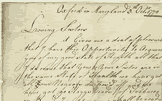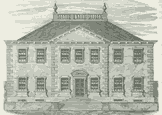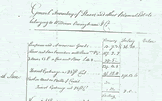|
Glasgow grew from a small town to a city of commerce
through its dominance of the tobacco trade from
the American colonies to Europe in the 18th century.
Glasgow merchants had financed trading missions
to the Chesapeake since 1707 and they began to
dominate the tobacco trade after 1740. Surprisingly,
only a small proportion of Glasgow’s merchants
were regularly involved in the tobacco trade with
the big three syndicates headed by William Cuninghame,
Alexander Speirs and John Glassford.
The Glasgow merchants
used a store system along the shores of the Chesapeake
- Maryland and Virginia. The stores were looked
after by Scottish factors who stockpiled hogsheads
of tobacco in anticipation of the arrival of a
company vessel, which ensured a rapid turnaround.
The factors offered credit as well as consumer
goods, plantation equipment and money in exchange
for tobacco. Many of the bigger stores used slave
labour to work on company farms which provided
food for the storekeeper and his assistants and
also to carry out general labouring tasks.
The Glasgow tobacco lords
made their money from re-exporting tobacco through
Scottish ports as well as by handling the domestic
demand for tobacco. They invested their money
in industry and land and many built townhouses
in the centre of Glasgow, spreading westwards
from Trongate.
The outbreak of the American
War of Independence in 1775 sparked the beginning
of the end of the tobacco age. The American planters
were heavily in debt to the Glasgow merchants
and collection of these debts was impossible during
hostilities. Glasgow tobacco fleets were also
seriously threatened by hostile action. In 1783
when peace came, the now independent United States
could send tobacco direct to Europe, cutting out
the need for the Glasgow merchants.
Staff in Glasgow City
Archives and Special Collections are actively
seeking records relating to Glasgow’s black history
to add to their collections. Do you know of any
organisations, businesses or individuals who may
have records they would like to deposit? If you
do and would like to discuss the potential deposit,
please contact the Duty
Archivist.
TOP |
Letter from William Colhoun


Map
of central Glasgow, 1807


Illustration of Shawfield mansion,
Glasgow.


Claim of American loyalist


|